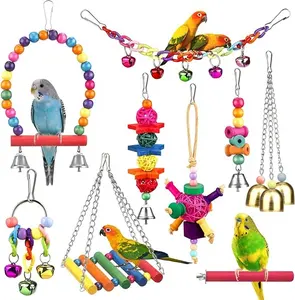Introduction to Choosing Bird Feeders
Choosing a bird feeder can be an exciting venture for nature lovers and birdwatching enthusiasts. These delightful structures not only provide nourishment for various bird species but also create a vibrant ecosystem in your garden, enhancing its beauty and diversity. A well-chosen bird feeder attracts a multitude of birds, allowing you to enjoy their songs and lively antics up close. In this guide, we'll explore essential factors in choosing bird feeders, helping you create a haven for your feathered friends.
Types of Bird Feeders
When it comes to choosing bird feeders, understanding the different types available is crucial for attracting your desired visitors. Each type serves different bird species and feeding habits:
- Tube Feeders: Ideal for small birds like finches and chickadees, these feeders feature multiple feeding ports and are typically designed to hold seed blends.
- Platform Feeders: These open feeders can accommodate various birds, including larger species such as cardinals and jays, as they allow easy access and ample space for feeding.
- Hopper Feeders: Resembling small houses, hopper feeders dispense seeds from the top and can attract a diverse range of birds thanks to their larger seed capacity.
- Suet Feeders: Specifically made for suet cakes, these feeders attract woodpeckers, nuthatches, and other insects-loving birds, making them perfect in colder months.
Function, Feature, and Design of Bird Feeders
Choosing bird feeders goes beyond aesthetics; functionality and features should be at the forefront of your decision-making process. Here are key aspects to consider:
- Durability: Look for feeders made from robust materials such as metal or weather-resistant plastic to withstand the elements over time.
- Easy Refilling: Select designs that allow for convenient refilling and cleaning to ensure the feeder remains a healthy feeding station.
- Perches and Ports: Assess the placement of perches and feeding ports, as their size will affect accessibility for different bird sizes.
- Seed Control: Some feeders come with built-in mechanisms to reduce seed spillage and wastage, making them more efficient for both birds and your budget.
How to Choose the Right Bird Feeder
With various options available, choosing the right bird feeder can be daunting. Here are practical steps to guide your selection:
- Identify Your Birds: Research the common bird species in your area to select feeders compatible with their feeding preferences.
- Consider Your Space: Evaluate the area where you'll place your bird feeder; both hanging and pole-mounted options will serve different spatial needs.
- Feeding Habits: Determine whether you prefer to offer seed, suet, nectar, or fruit, as each type of bird feeder is tailored to specific diets.
- Seasonal Needs: Think about the seasons; certain feeders are better suited for winter feeding when birds require more calories, while others are optimal during migration periods.
Advantages of Choosing the Right Bird Feeder
Choosing the right bird feeder not only enhances your garden's allure but also provides numerous benefits:
- Encourages Wildlife Watching: An appropriately placed bird feeder allows for easy observation of birds, creating a delightful experience for the entire family.
- Supports Local Ecosystems: By providing food, you contribute positively to local bird populations and promote biodiversity in your area.
- Educational Opportunities: Bird feeders can serve as a learning tool for children and adults alike, fostering an appreciation of nature and wildlife conservation.
- Stress Relief: Observing birds can be a soothing activity that helps reduce stress and enhances emotional well-being.















































